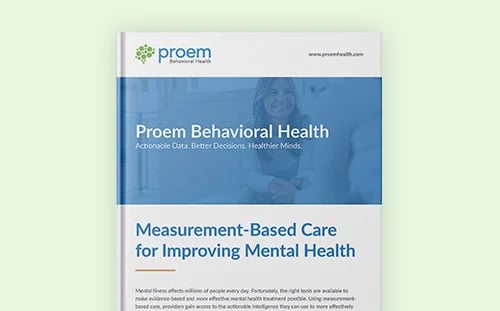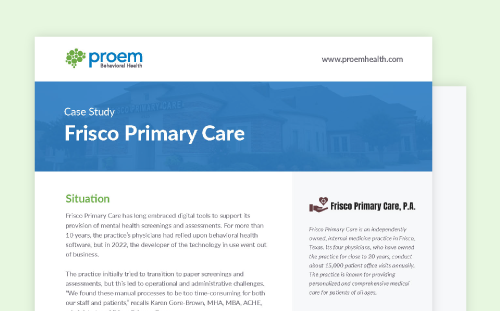Medicare began reimbursing behavioral health integration (BHI) codes on Jan. 1, 2018. Some private insurers also cover BHI. However, BHI is still new territory for many primary care providers (PCPs). This is changing, however, as PCPs discover the important role integrated behavioral health plays in a “whole-person” approach to medicine.

Some of the challenges PCPs face concerning BHI include the following:
- Having insufficient time to delve into behavioral issues due to the volume of patients waiting to be seen
- A shortage of resources for efficiently coordinating with a patient’s other healthcare providers
- A lack of access to tools for tracking and treating behavioral health issues
- Not understanding how PCPs can bill for BHI
- The need for greater awareness around the integrated behavioral health model in primary care
- Particularly in severe cases, PCPs may simply feel unprepared to manage substance use disorders or mental health conditions in patients
In this article, we’ll address some of these concerns and discuss ways for PCPs to go about integrating behavioral health and primary care into their practice.
What is the major role of the primary care provider working within an integrated behavioral healthcare model?
As the term suggests, primary care providers are often a patient’s “first point of contact” with the wider healthcare system. With up to 75% of primary care visits involving some component of mental or behavioral health, PCPs often sit at the nexus of the primary care/behavioral health model and are thus well-positioned to promote it among patients.
Interventions might include:
- Patient education
- Investigating behavior as an underlying cause or factor in conditions that may initially present with purely physiological symptoms (e.g., uncontrolled diabetes rooted in a patient’s anxiety about needles)
- More frequent “check-ins” to evaluate medication/treatment adherence
- Referral to a specialist for further diagnosis and/or treatment
All these potential interventions stem from the idea that the earlier behavioral and/or mental health issues are identified, the better the chances for a positive outcome. Since many patients initially turn to their PCP when a medical issue arises, PCPs have a vital role to play in educating and getting “buy-in” from patients about the benefits of an integrated behavioral health model in primary care.
It’s not just the patients who benefit from integrated behavioral health. The American Academy of Family Physicians Foundation states that integrated behavioral health has been shown to “improve depression scores and improve the patient and physician experiences.” Researchers have concluded that “this new integrated approach to behavioral health will strengthen primary care as well."
How can PCPs effectively implement the integrated primary care behavioral health model?
The American Psychological Association (APA) identifies the two most widely adopted BHI models: primary care behavioral health model (PCBH) and the collaborative care model (CoCM). To summarize, PCBH, also referred to as the primary care behaviorist model, includes a licensed behavioral health professional serving as an essential member of the primary care team. The model sees providers taking a systematic approach to addressing mental health and substance use disorders as well as the many behavioral factors affecting all health conditions.
CoCM is based on a chronic care management (CCM) approach. It involves psychiatric services and brief psychoeducation or motivational interviewing for a defined group of primary care patients who are diagnosed with chronic mental illness (most commonly major depression). Services are provided by a team comprised of a PCP, a care manager and an on- or off-site psychiatrist consulting with the team.
While these models are defined by APA, the association notes the importance of taking an approach that supports the uniqueness and needs of the specific patient population and primary care team to best address overall population health:
“APA believes in adopting evidence-based integrated behavioral health services, recognizing that a one-size-fits-all model will not work for all primary care settings. Instead, APA emphasizes that the primary care practice's needs, internal and community-based resources, practice-based goals, and, importantly, patient population be the drivers for determining the best approach to care.”
One of the most practical and effective ways for integrating behavioral health and primary care as foundational components of a PCP’s practice is by making it less complicated, time-consuming and labor-intensive to implement the core tenets of BHI.
While that’s perhaps easier said than done, employing technology and tools, such as those offered by Proem, offer significant advantages, including the following:
- Workflows that increase the efficiency and accuracy of diagnoses
- A single platform that provides evidenced-based, clinically validated, licensed digital tools to assess multiple conditions — and reduces inherent biases, screens for co-morbidities and identifies possible root causes
- Built-in tracking tools for patient outcomes, alleviating obstacles that have historically led to poor follow-up and coordination of services
Beyond patient health, how do PCP practices benefit from BHI?
Now that the components of BHI have specific CPT codes for use in billing insurance plans (including Medicare) for services rendered, tasks such as coordinating patient care with outside providers, “extra” time spent educating patients about possible behavior-related issues, and other such time- and labor-intensive tasks represent a new revenue stream. Given the volume of behavior-related PCP visits, it’s a potentially lucrative one.
Proem unites PCPs and other integrated behavioral health providers around a single solution with built-in assessment tools and workflows designed to facilitate collaboration while protecting PHI. With automated reports for tracking outcomes and documenting progress, our software keeps track of data needed for billing BHI CPT codes as well. To find out more about how Proem’s exclusively licensed digital tools and workflow solutions can support an integrated behavioral health model in primary care and BHI, book a meeting. We’d love to help!





.png)









